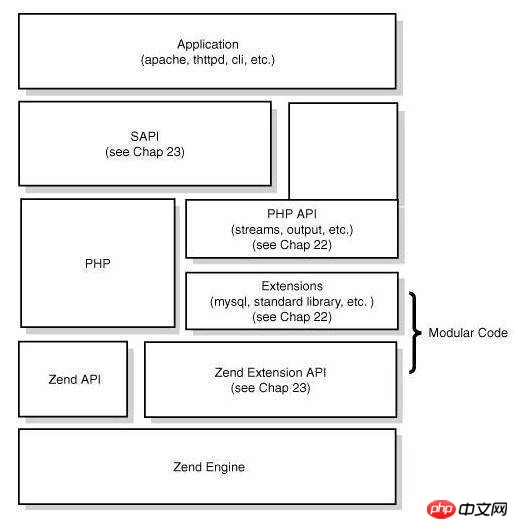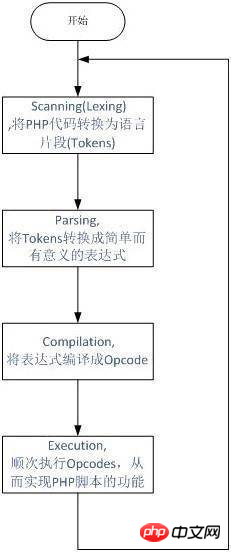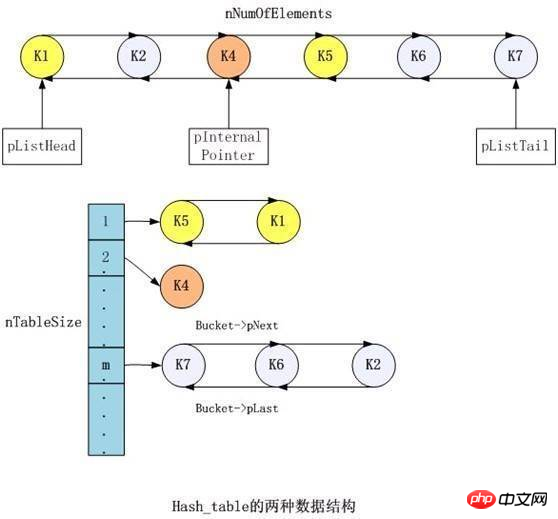
PHP is said to be simple, but it is not easy to master it. In addition to being able to use it, we also need to know its underlying working principle.
PHP is a dynamic language suitable for web development. To be more specific, it is a software framework that uses C language to implement a large number of components. In a more narrow sense, it can be considered as a powerful UI framework.
What is the purpose of understanding the underlying implementation of PHP? To use dynamic language well, we must first understand it. Memory management and framework models are worthy of our reference. Through extended development, we can achieve more powerful functions and optimize the performance of our programs.
The design concept and characteristics of PHP
Multi-process model: Since PHP is a multi-process model, different requests do not interfere with each other, which ensures that one request will not hang up. It will affect the entire service. Of course, with the development of the times, PHP has already supported the multi-threading model.
Weakly typed language: Unlike C/C++, Java, C# and other languages, PHP is a weakly typed language. The type of a variable is not determined at the beginning. It is determined during operation and implicit or explicit type conversion may occur. The flexibility of this mechanism is very convenient and efficient in web development. The details will be discussed in PHP later. Variables are detailed in.
The engine (Zend) + component (ext) model reduces internal coupling.
The middle layer (sapi) isolates the web server and PHP.
The syntax is simple and flexible, without too many specifications. Shortcomings lead to mixed styles, but no matter how bad a programmer is, he will not write a program that is too outrageous and endangers the overall situation.
PHP’s four-layer system
The core architecture of PHP is as shown below:

You can see from the picture Out, PHP is a 4-layer system from bottom to top:
Zend engine: Zend is implemented entirely in pure C and is the core part of PHP. It translates PHP code (lexical, syntax analysis and other compilation processes ) is used to process executable opcodes and implement corresponding processing methods, implement basic data structures (such as hashtable, oo), memory allocation and management, and provide corresponding api methods for external calls. It is the core of everything and all peripherals. The functions are all implemented around Zend.
Extensions: Around the Zend engine, extensions provide various basic services in a component-based manner. Our common built-in functions (such as array series), standard libraries, etc. are all implemented through extensions. Users also You can implement your own extension as needed to achieve function expansion, performance optimization and other purposes (for example, the PHP middle layer and rich text parsing currently used by Tieba are typical applications of extension).
Sapi: The full name of Sapi is Server Application Programming Interface, which is the server application programming interface. Sapi enables PHP to interact with peripheral data through a series of hook functions. This is a very elegant and successful design of PHP. Through sapi, PHP itself is successfully decoupled and isolated from the upper-layer application. PHP can no longer consider how to be compatible with different applications, and the application itself can also implement different processing methods according to its own characteristics.
Upper-layer application: This is the PHP program we usually write. We obtain various application modes through different sapi methods, such as implementing web applications through webserver, running them in script mode on the command line, etc.
If PHP is a car, then the frame of the car is PHP itself, Zend is the engine (engine) of the car, the various components under Ext are the wheels of the car, and Sapi can be regarded as a road,
Cars can run on different types of roads, and the execution of a PHP program means the car runs on the road. Therefore, we need: a high-performance engine + the right wheels + the right track.
3.Sapi
As mentioned earlier, Sapi allows external applications to exchange data with PHP through a series of interfaces and can implement specific functions according to the characteristics of different applications. Some of our common sapi processing methods are:
apache2handler: This is the processing method when using apache as the webserver and running in mod_PHP mode. It is also the most widely used one now.
cgi: This is another direct interaction method between webserver and PHP, which is the famous fastcgi protocol. In recent years, fastcgi+PHP has been used more and more, and it is also the only method supported by asynchronous webserver. .
cli: Application mode for command line calls
4.PHP execution process&opcode
Let’s first take a look at the execution process of the PHP code process.

As you can see from the picture, PHP implements a typical dynamic language execution process: after getting a piece of code , after lexical parsing, syntax parsing and other stages, the source program will be translated into instructions
(opcodes), and then the ZEND virtual machine will execute these instructions in sequence to complete the operation. PHP itself is implemented in C, so the functions that are ultimately called are all C functions. In fact, we can regard PHP as a software developed in C.
The core of PHP execution is the translated instructions, that is, opcode.
Opcode is the most basic unit of PHP program execution. An opcode consists of two parameters (op1, op2), return value and processing function. The PHP program is ultimately translated into the sequential execution of a set of opcode processing functions.
Several common processing functions:
ZEND_ASSIGN_SPEC_CV_CV_HANDLER : 变量分配 ($a=$b) ZEND_DO_FCALL_BY_NAME_SPEC_HANDLER:函数调用 ZEND_CONCAT_SPEC_CV_CV_HANDLER:字符串拼接 $a.$b ZEND_ADD_SPEC_CV_CONST_HANDLER: 加法运算 $a+2 ZEND_IS_EQUAL_SPEC_CV_CONST:判断相等 $a==1 ZEND_IS_IDENTICAL_SPEC_CV_CONST:判断相等 $a===1
5.HashTable - core data structure
HashTable is the core data structure of zend, in PHP It is used to implement almost all common functions. The PHP array we know is its typical application. In addition, within zend, such as function symbol table, global variables, etc. are also implemented based on hash table.
PHP’s hash table has the following characteristics:
Supports typical key->value query
Can be used as an array
Add and delete nodes are O(1) complexity
Key supports mixed types: there are associated number combination index arrays at the same time
Value supports mixed types: array ("string",2332)
Supported Linear traversal: For example, foreach
Zend hash table implements a typical hash table hash structure, and at the same time provides the function of forward and reverse traversal of the array by attaching a doubly linked list. Its structure is as shown below:

It can be seen that in the hash table, there are both hash structures in the form of key->value and doubly linked list mode, making it very Conveniently supports fast search and linear traversal.
Hash structure: Zend's hash structure is a typical hash table model, which resolves conflicts through a linked list. It should be noted that zend's hash table is a self-growing data structure. When the hash table is full, it will dynamically expand by 2 times and reposition elements. The initial size is 8. In addition, when performing key->value fast search, zend itself has also made some optimizations to speed up the process by exchanging space for time. For example, a variable nKeyLength is used in each element to identify the length of the key for quick determination.
Doubly linked list: Zend hash table implements linear traversal of elements through a linked list structure. Theoretically, it is enough to use a one-way linked list for traversal. The main purpose of using a doubly linked list is to quickly delete and avoid traversal. Zend hash table is a composite structure. When used as an array, it supports common associative arrays and can also be used as sequential index numbers, and even allows a mixture of the two.
PHP associative array: Associative array is a typical hash_table application. A query process goes through the following steps (as can be seen from the code, this is a common hash query process and adds some quick judgments to speed up the search.):
getKeyHashValue h; index = n & nTableMask; Bucket *p = arBucket[index]; while (p) { if ((p->h == h) && (p->nKeyLength == nKeyLength)) { RETURN p->data; } p=p->next; } RETURN FALTURE;
PHP index array: The index array is our common array , accessed via subscript. For example, $arr[0], Zend HashTable is internally normalized, and the hash value and nKeyLength (0) are also assigned to the index type key. The internal member variable nNextFreeElement is the currently assigned maximum id, which is automatically increased by one after each push. It is this normalization process that allows PHP to achieve a mixture of associative and non-associative data. Due to the particularity of the push operation, the order of the index keys in the PHP array is not determined by the size of the subscript, but by the order of the push. For example, $arr[1] = 2; $arr[2] = 3; for double type keys, Zend HashTable will treat them as index keys
6.PHP variables
PHP is a weakly typed language and does not strictly distinguish the types of variables. PHP does not need to specify the type when declaring variables. PHP may perform implicit conversions of variable types during program execution. Like other strongly typed languages, explicit type conversion can also be performed in the program. PHP variables can be divided into simple types (int, string, bool), collection types (array resource object) and constants (const). All the above variables have the same structure zval under the hood.
Zval is another very important data structure in zend, used to identify and implement PHP variables. Its data structure is as follows:

Zval is mainly composed of three Part composition:
type: specifies the type of variable (integer, string, array, etc.)
IS_LONG -> lvalue IS_DOUBLE -> dvalue IS_ARRAY -> ht IS_STRING -> str IS_RESOURCE -> lvalue
When performing an assignment operation, zend points the variable to the same zval and ref_count++, and during the unset operation, the corresponding ref_count-1. The destruction operation will only be performed when ref_count is reduced to 0. If it is a reference assignment, zend will modify is_ref to 1.
PHP variables realize variable sharing data through reference counting. What if you change the value of one of the variables? When trying to write a variable, if Zend finds that the zval pointed to by the variable is shared by multiple variables, it will copy a zval with a ref_count of 1 and decrement the refcount of the original zval. This process It's called "zval separation". It can be seen that the copy operation is only performed when a write operation occurs
zend, so it is also called copy-on-write(copy on write)
For reference variables, the requirements are the same as non-reference On the contrary, variables assigned by reference must be bundled. Modifying one variable modifies all bundled variables.
Integers and floating-point numbers are one of the basic types in PHP and are also simple variables. For integers and floating point numbers, the corresponding values are stored directly in zvalue. Its types are long and double respectively.
As can be seen from the zvalue structure, for integer types, unlike strongly typed languages such as c, PHP does not distinguish between int, unsignedint, long, long, long
long and other types. For example, there is only one type of integer, which is long. From this, it can be seen that in PHP, the value range of integers is determined by the number of compiler bits and is not fixed.
For floating point numbers, similar to integers, it does not distinguish between float and double but only double.
In PHP, what should I do if the integer range is out of bounds? In this case, it will be automatically converted to double type. You must be careful about this, as many tricks are caused by this.
Like integers, character variables are also basic types and simple variables in PHP. It can be seen from the zvalue structure that in PHP, a string is composed of a pointer to the actual data and a length structure, which is similar to the string in C++. Since the length is represented by an actual variable, unlike c, its string can be binary data (including \0). At the same time, in PHP,
finding the string length strlen is an O(1) operation .
When adding, modifying, or appending string operations, PHP will reallocate memory to generate new strings. Finally, for security reasons, PHP will still add \0 at the end when generating a string.
Common string splicing methods and speed comparison:
Assume there are the following 4 variables: $ strA='123'; $strB = '456'; $intA=123; intB=456;
Now we will compare and explain the following string splicing methods:
$res = $strA.$strB and $res = “$strA$strB”
In this case, zend will re-malloc a piece of memory and perform the corresponding processing Processing, its speed is generally
$strA = $strA.$strB
This is the fastest, zend will be in the current strA Basically, directly relloc to avoid repeated copies
$res = $intA.$intB
This is slower because it needs to be hidden Format conversion, you should also pay attention to avoid when actually writing the program
$strA = sprintf (“%s%s”,$strA.$strB);
This will be the slowest way, because sprintf is not a language structure in PHP. It takes a lot of time to identify and process the format. In addition, the mechanism itself is malloc. However, the sprintf method is the most readable, and in practice it can be chosen flexibly according to specific circumstances.
PHP arrays are naturally implemented through Zend HashTable.
through foreach is much more efficient than for, eliminating the need to search for key->value. The count operation directly calls
HashTable->NumOfElements, O(1) operation. For a string like '123', zend will be converted to its integer form
. $arr[‘123’] and $arr[123] are equivalent
The resource type variable is the most complex variable in PHP and is also a composite structure.
PHP's zval can represent a wide range of data types, but it is difficult to fully describe custom data types. Since there is no efficient way to represent these composite structures, there is no way to use traditional operators on them. To solve this problem, you only need to refer to the pointer through an essentially arbitrary identifier (label), which is called a resource.
In zval, for resource, lval is used as a pointer, directly pointing to the address of the resource. Resource can be any composite structure. The familiar mysqli, fsock, memcached, etc. are all resources.
How to use resources:Registration:For a custom data type, you want to use it as a resource. First, you need to register it, and zend will assign it a globally unique identifier.
Get a resource variable: For resources, zend maintains an id->hash_tale of actual data. For a resource, only its id is recorded in zval. When fetching, find the specific value in the hash_table through the id and return it.
Resource destruction:The data types of resources are diverse. Zend itself has no way to destroy it. Therefore, users need to provide a destruction function when registering resources. When unset resources, zend calls the corresponding function to complete the destruction. Also delete it from the global resource table.
Resources can persist for a long time, not only after all variables that reference it go out of scope, but even after a request ends and a new request is generated. These resources are called persistent resources because they persist throughout the life cycle of the SAPI unless specifically destroyed. In many cases, persistent resources can improve performance to a certain extent. For example, in our common mysql_pconnect, persistent resources allocate memory through pemalloc so that they will not be released when the request ends. For zend, there is no distinction between the two per se.
How are local variables and global variables implemented in PHP? For a request, PHP can see two symbol tables (symbol_table and
active_symbol_table) at any time, with the former used to maintain global variables. The latter is a pointer pointing to the currently active variable symbol table. When the program enters a function, zend
will allocate a symbol table x to it and point active_symbol_table to a. In this way, the distinction between global and local variables is achieved.
Get variable values: PHP's symbol table is implemented through hash_table. Each variable is assigned a unique identifier. When obtaining, the corresponding zval is found from the table and returned according to the identifier.
Using global variables in functions: In functions, we can use global variables by explicitly declaring global. Create a reference to the variable with the same name in symbol_table in active_symbol_table. If there is no variable with the same name in symbol_table, it will be created first.
Related articles:
In-depth interpretation of PHP operating mechanism
In-depth interpretation of PHP operating mechanism. Let’s take a look at the following PHP operating mechanism process: 1. We have never manually started the PHP-related processes, it is along with the Ap...
The above is the detailed content of An explanation of the underlying operating mechanism and principles of PHP. For more information, please follow other related articles on the PHP Chinese website!




